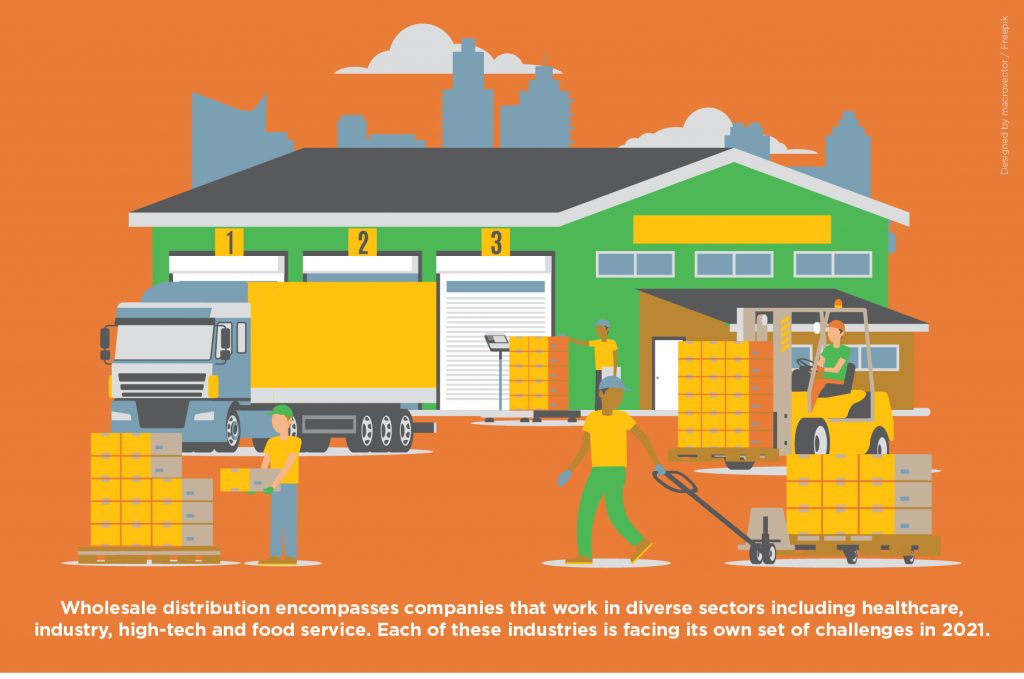Wholesale distribution had a tumultuous 2020. The COVID-19 pandemic catalyzed major disruptions to both supply and demand, prompting many manufacturers to suspend their operations as business dwindled or, alternatively, struggled to accommodate higher buying activity.
Consider that the stock prices of food service distributors dropped 50% in a matter of weeks in 2020, and that demand for kitchen equipment also plunged 80% over this period, per McKinsey. Meanwhile, wholesale distributors of healthcare products saw opposite trends, as the need for pharmaceuticals sharply increased, outstripping the ability of global supply chains to keep up amid travel restrictions and public health measures, according to CNBC.
But as sudden and drastic as these changes were, they ultimately intensified some familiar, long-term trends in wholesale distribution. For years, distributors have been in the process of digitally transforming the processes and technologies that support critical activities like planning, forecasting and logistics — and the pandemic only accelerated these shifts.
With that overarching trend in mind, let’s look at some other trends as well as some key challenges for 2021 and beyond.

1. Ecommerce and omnichannel sales in the spotlight
Distribution continues to transform into e-commerce. B2B buyers now expect features similar to what’s available on sites like Amazon, such as straightforward searchability of, and visibility into, distributor inventory, plus easy product research and purchasing without having to interact with a sales rep. On the eve of COVID-19, one in ten distributors was already making at least 81% of its revenue off B2B e-commerce.
McKinsey also found that the share of B2B buyers seeking self-service throughout their customer journeys more than doubled between 2016 and 2019. In response, distributors have focused on building out digital experiences, not only to retain the loyalty of these customers but to avoid being disintermediated by suppliers who are increasingly trying to sell directly to end customers.
Modernizing their services for buyers will be key if distributors are to remain competitive with the growing number of nontraditional players in their market. Omnichannel sales are particularly important here, since buyers expect straightforward experiences regardless of device or application type, and distributors have sometimes lagged other organizations in providing such experiences.
2. Deeper automation and data integration in the cloud
The main question, then, is what specific steps should wholesale distributors take to build these types of experiences? More often than not, cloud technologies, such as industry-specific Platform-as-a-Service solutions, offer the most straightforward path toward modernization.
Oracle itself has highlighted how its cloud modules have enabled industrial distributors to streamline their supply chains and adapt to the new pressures created by both COVID-19 and changes in customer expectations. For one customer, Oracle’s cloud-based warehouse management systems was the engine behind the rollout of thousands of specialized vending machines at customer sites. These machines saved customers a risky trip to the nearest branch office and increased sales by 10%.
Inspirage delivered similar benefits to a 3PL that had been looking to revamp its entire value chain. This company upgraded from Navision to a cloud-based solution to better serve its mobile workforce, reduce costly clerical errors and adapt to rapidly evolving business requirements. Be sure to read the entire case study for more information on how this cloud supply chain transformation happened.

3. Divergent trends across wholesale distribution industries
Wholesale distribution encompasses companies that work in diverse sectors including healthcare, industry, high-tech and food service. Each of these industries is facing its own set of challenges in the 2020s:
- Healthcare distributors must adjust to high demand for pharmaceuticals like vaccines and the difficulties inherent in globe-spanning supply chains.
- Industrial distributors must deal with more customers shifting to a remote sales preference (away from face-to-face) and expecting payment condition concessions.
- High-tech distributors must confront shortages of key materials like semiconductors even as demand ramps up for upgrade cycles driven by 5G adoption, among other trends.
- Food service distributors must navigate a potentially sharp rebound in demand as more businesses re-open in the wake of COVID-19 vaccination campaigns.
Across all sectors, Inspirage can provide the experience and expertise with Oracle solutions to help distributors upgrade their business-critical systems. Learn more about our supply chain solutions by connecting with our team today.